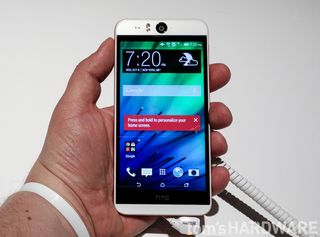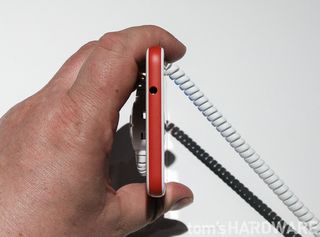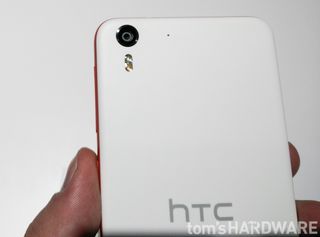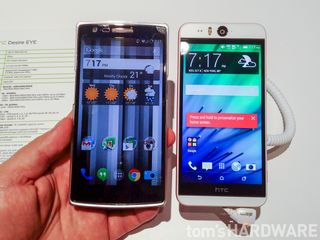Hands On With The HTC Desire EYE Smartphone

At yesterday’s "Double Exposure" event, HTC announced its latest handset, the mid-range Desire EYE, which is exclusive to AT&T in the U.S. At the event, we got a chance to get a brief hands on with it, which you can check out in our video below.
The Desire EYE’s standout feature is its 13 MP front-facing (with dual-LED flash!) camera that matches the back camera's resolution. While this feature is obviously designed to attract the younger selfie-taking crowd, the rest of the phone is nothing to sneeze at.
It's rather well-spec’d, despite being part of HTC’s Desire series of mid-range devices. In fact, if it is priced right (say, $450 or under outright), it could be one of the new best values in Android phones. However, with its higher-end specs, HTC does find itself with a mid-tier phone very similar internally to its flagship One M8, so there have been some compromises made to bring down the cost.

Specifications
| Header Cell - Column 0 | HTC Desire EYE Specifications |
|---|---|
| SoC | Qualcomm Snapdragon 801 MSM8974AB |
| CPU Core | Krait 400 (4-core) @ 2.26 GHz |
| GPU Core | Adreno 330 @ 578 MHz |
| Memory | 2 GB RAM |
| Display | 5.2-inch Full HD IPS (1920 x 1080, 424 ppi) |
| Storage | 16 GB |
| Battery | 2,400 mAh (removable) |
| Camera(s) | Front: 13MP, BSI sensor, f/2.2, 22mm lens, wide angle, with HDR capability & dual LED flashRear: 13MP, BSI sensor, f/2.0, 28mm lens, wide angle, with HDR capability & dual LED flash |
| Expansion Ports | microSD slot, USB 2.0 |
| Connectivity | Wi-Fi: 802.11b/g/nCellular: LTE AT&T - bands 2, 4, 5, 17, 29Other: Bluetooth 4.0, NFC |
| Dimensions | 5.97" x 2.91" x 0.33" (151.7 x 73.8 x 8.5 mm) |
| Weight | 5.43 oz (154 g) |
| Operating System | Android 4.4.4 Kitkat w/ HTC Sense 6 |
| Price | $TBA |
Design
The Desire HTC, befitting its mid-tier status, is an all-plastic device. Despite this, and because it’s an HTC phone, is also still looks like a premium device and feels great in the hand, with a nice overall soft-touch finish to the plastic. The AT&T model only comes in an attractive white and orange finish, which is disappointing for users who perhaps don’t want a white device. In other markets there is also an EYE with a navy blue back, which I am sure would be appealing to many US customers. One impressive aspect of the EYE’s plastic finish is that there is no visible seam between the white and orange layer, something HTC achieved by using what they termed a ‘dual shot’ moulding technique for the EYE’s chassis.

Button- and port-wise, it doesn’t stray too far from the Android norm. Thankfully the power button is on the right side below the volume rocker, instead of awkwardly on top like many other HTC phones. The EYE also has a physical camera shutter button, something left off so many Android phones and in our opinion an essential feature.
On the left side are the slots for the nano SIM and a microSD card. Unfortunately, despite what some rumors indicated, the back is not removable, so the battery can’t be changed. There is a reason for this though – the Desire EYE is the first waterproof HTC phone available in North America. It is IPX7 rated, which means it doesn’t have any dust resistance, but it is capable of being submerged in 1 meter of water for 30 minutes.

As far as dimensions go, the Desire EYE is a pretty big device, though we wouldn't go as far as saying it's too big. It has a 5.2-inch screen with reasonably sized bezels surrounding it, but because HTC had to fit the 13 MP front-facing camera and LED flash above the screen, the EYE ends up being a pretty tall phone, only slight shorter than the OnePlus One, and quite a bit longer than the HTC One M8. Its 154 grams is a reasonable weight for a phone of this size.
Stay on the Cutting Edge
Join the experts who read Tom's Hardware for the inside track on enthusiast PC tech news — and have for over 25 years. We'll send breaking news and in-depth reviews of CPUs, GPUs, AI, maker hardware and more straight to your inbox.
Screen
The Desire EYE has a 5.2-inch Full HD display, which works out to a PPI of 424, which is pretty crisp. While it is a big screen, as mentioned above, the bezels surrounding it aren’t too thick, keeping the EYE’s width down. We weren’t able to run any tests on the screen at the event, so don’t know exactly how bright it is or how color accurate, but it did seem very bright at the event, and it had good viewing angles.
We also weren’t able to find out if the EYE uses a Super LCD panel like the One M8, and it’s possible it does not; HTC may have gone a different direction in order to keep the price down. Also, another compromise has been made on the glass covering the screen – it is not Gorilla Glass, and while we are sure it is scratch resistant, we weren’t able to find out exactly what type it is.
Camera
So as I mentioned at the beginning, the Desire EYE’s marquee feature is its front-facing 13 MP camera. Both the front and rear camera use the same 13 MP BSI CMOS Sony IMX214 sensor as found on some of its other phones, such as the HTC Butterfly 2 (though it could also be the lower quality OmniVision sensor used by the Desire 816). That means of course that the EYE doesn’t incorporate any of the Ultrapixel technology found in the flagship One M8, nor is the duo-camera (which is used for adding depth effects to pictures) present.

While the sensors in both cameras are the same, the optics in the front of them are slightly different. The rear camera has a 28 mm wide lens with an f/2.0 aperture, which should allow for decent performance in low-light. The front camera’s lens is a wider 22 mm, allowing to fit more of your friends in when you are trying to pull an Ellen.
The EYE also has a dual-LED flash on both the back and front of the phone, though we were only able to test out how the front flash worked. We assume that it is not as powerful as the rear flash, because most of the time the subjects that the front camera will be photographing will be close. For video, both cameras are capable of shooting 1080p video. Unfortunately, while the sensor and ISP of the SoC in EYE should be more than capable of shooting 4K video, this resolution is not supported.
Of course, camera hardware is only half the story, so in order to maximize the imaging potential that having two high resolution cameras on a phone allows, HTC has added a number of features to its already excellent camera software. HTC is calling these features the EYE Experience, and it also plans to bring them to other HTC phones too.

However, since none of them have such a high-resolution camera on the front, the EYE will still be considered the premium device for this new Experience. The two modes that take advantage of both cameras at the same time are Split Capture and Crop Me In. Split Capture can shoot stills or video using both 13 MP cameras simultaneously, and Crop Me in is a picture-in-picture mode that allows you to resize and position the insert images anywhere in the frame. We only got to briefly play with these mode at our launch event hands-on, but HTC did demo them to use in an earlier meeting, and they worked very well, though the questions remains if being able to shoot with both cameras at once is anything more than a novelty.
The other stand-out features of the EYE Experience are focused on the front-facing camera. One is Auto Selfie, which automatically takes a picture after the phone has been held steady for a few seconds, and another isthat the EYE allows you to use voice commands to take a selfie. Both features are designed to minimize the awkward contortions you have to put you hand through to hit the onscreen or physical shutter button while holding the phone at arms-length in front of you.

The EYE experience also enhances the video-calling experience, by using face tracking to keep you centered in the frame on your call, even if you are moving around. Sadly, HTC was not able to demonstrate video calling to use in person, nor could we test it at the event, so we are not able to say how well the face-tracking feature works.
Overall having such a high resolution camera on the front of a phone does open up some intriguing possibilities, and even if you are not a selfie taker, there are still some creative uses for it, and it should improve the video calling experience. The only concern we have is that the same 13 MP sensor and camera hardware setup in other HTC phones hasn’t always produced the best images, especially in low light. However, we’ll have to wait until we can test out the camera properly before drawing any final conclusions.
Hardware Specs And Audio
There are no surprises as far as the rest of the Desire EYE’s hardware goes, unless if you count that it is surprising that HTC equipped a mid-range phone with some pretty powerful components. To be honest though, the phone's Snapdragon 801 isn’t the latest and greatest from Qualcomm anymore (hello 805), so it could be argued that 801 is now really a mid-tier component. The eye uses the same 2.26 GHz MSM8974AB variant of the 801 that the HTC One M8 and E8 uses, and it also has 2 GB of RAM, so on paper all three of these phones should perform very similarly. Of course, the plastic design of the EYE means that its thermal properties are going to be closer to the E8 rather than the metal-bodied M8 that is able dissipate heat from the SoC much more efficiently.
On the storage front, the EYE only comes with 16 GB of internal storage, which is a little low for a modern device, but this, of course, is another way for HTC to keep the EYE’s costs down. There is a microSD slot so you can add up 128 GB of additional storage. It has a 2,400 mAh battery, which is a bit smaller than the 2,600 mAh found in the M8. This means that you can expect the EYE to last a couple of hours less, but we obviously weren’t able to test this yet, and it still means that you should be able to get a good day of use from the EYE without having to tether yourself to an outlet by 5pm.
As for connectivity, another cut that HTC made to lower the price is that the EYE does not support wireless AC, just a/b/g/n. For cellular connectivity, the EYE on AT&T supports LTE bands 2, 4, 5, 17 and 29. In contrast to the cost-cutting measure applied to connectivity, HTC did not compromise on the audio front. The EYE still has the same front-facing BoomSound speakers with built-in amplifiers of the One M8, although this time it's discretely positioned on the edge of the top and bottom bezel of the screen.
One thing we were NOT able to do during our hands on time with the EYE was run any performance benchmarks. Since the units on display were pre-production units running in a demo mode, we didn’t think any results that we would gather would be indicative as to how the phone you’ll be able to buy will perform, but seeing as its hardware specs are almost identical to the HTC One E8’s, you can read our review to see how it performed to get an idea of how the EYE might fare.
Software
Other than the updated camera software features, not much has changed with regards to the rest of the HTC EYE’s software. It is still running Android KitKat (but this time 4.4.4) with HTC’s attractive Sense 6 UX. While there are no new features, Sense is widely considered to be the best non-stock Android experience, so it is good that HTC has not messed with success. Also, like all of its phones, HTC is committed to delivering the latest version of Android to the EYE within 90 days of Google launching it, so with Android L’s launch expected within the next few weeks, we should see the EYE running L by early next year.
Follow us @tomshardware, on Facebook and on Google+
-
icemunk Same ol same ol' - I want some innovation; not just another look-a-like phone. I think I'm going to buy the Passport.Reply
Most Popular


